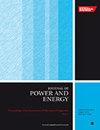Analysis of vortex combustion flow in a chamber of guide ring coupling with swirl flow
IF 1.1
4区 工程技术
Q3 ENGINEERING, MECHANICAL
Proceedings of the Institution of Mechanical Engineers, Part A: Journal of Power and Energy
Pub Date : 2023-10-30
DOI:10.1177/09576509231211756
引用次数: 0
Abstract
To investigate the impact of different vortex structure on the combustion stability in a chamber, this paper evaluates the performance of a vortex combustion chamber coupled with a swirler and a guide ring. The simulated cases include different guide ring angles of 95°, 105°, 115°, 125° and 135°, in addition to a control case without coupling the guide ring. The distributions of velocity, vorticity, temperature, outlet temperature distribution factor ( OTDF), reaction rate, turbulent kinetic energy ( k), synergy angle ( β), and NO emission are numerically analyzed. Results show that the coupling of the swirler and guide ring changes the vortex structure and significantly influences the chamber performance. The increase of the guide ring angles ( α) enhances the interaction between the swirl flow and the direct jet, which intensifies heat and mass transfer, as well as turbulence. The application of the guide ring induces external entrainment of the jet, leading to the formation of a large central recirculation zone compared to that without a guide ring. With increasing the α from 95° to 135°, both average outlet velocity and tangential velocity ( V t ) at the coaxial line position decrease, while the flame length decreases by 286 mm. And the OTDF variation among all cases is less than 0.065. The β of the central section decreases from 76.18° to 70.17°. Furthermore, combustion chamber without the guide ring exhibits higher temperature and OTDF.导流环耦合腔内涡流燃烧流场分析
为了研究不同涡结构对燃烧室内燃烧稳定性的影响,本文对旋涡器和导环耦合的涡燃烧室进行了性能评价。模拟工况包括不同导环角度的95°、105°、115°、125°和135°,以及不耦合导环的控制工况。对速度、涡度、温度、出口温度分布因子(OTDF)、反应速率、湍流动能(k)、协同角(β)和NO排放的分布进行了数值分析。结果表明,旋流器与导环的耦合改变了涡流结构,对腔体性能有显著影响。导环角(α)的增大增强了旋涡流与直喷流的相互作用,从而加剧了传热传质和湍流。与没有导环相比,导环的应用诱导了射流的外部夹带,导致形成了一个大的中央再循环区。当α角从95°增加到135°时,共轴线位置的平均出口速度和切向速度(V t)均减小,火焰长度减小286 mm。各病例间OTDF差异均小于0.065。中部截面的β由76.18°减小到70.17°。此外,没有导环的燃烧室表现出更高的温度和OTDF。
本文章由计算机程序翻译,如有差异,请以英文原文为准。
求助全文
约1分钟内获得全文
求助全文
来源期刊

CiteScore
3.30
自引率
5.90%
发文量
114
审稿时长
5.4 months
期刊介绍:
The Journal of Power and Energy, Part A of the Proceedings of the Institution of Mechanical Engineers, is dedicated to publishing peer-reviewed papers of high scientific quality on all aspects of the technology of energy conversion systems.
 求助内容:
求助内容: 应助结果提醒方式:
应助结果提醒方式:


